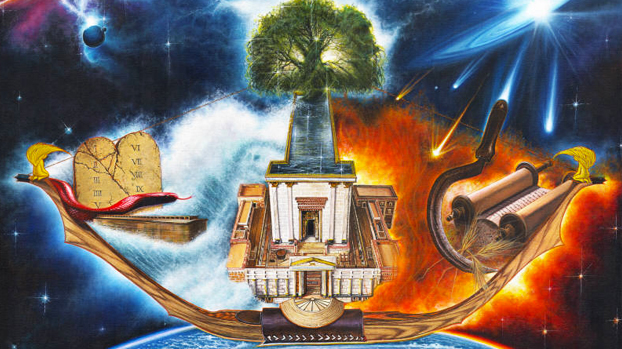
This incident is indicative of the kinds of struggles that young Modern Orthodox men and women are facing. Contrary to what the Orthodox Union would like to imagine, they do touch each other and they do want to talk about it. Or they don’t touch each other and want to talk about it. Some of them want to wear certain clothing, sleep with serious partners, hook up at bars. They also want to keep Shabbat, eat in only Kosher restaurants, and pray three times a day. They want community and continuity but they struggle against their hormones. Many choose to get married very young, while others keep their sexual exploits quiet and hidden. Some feel tremendous guilt and leave the system behind all together in order to avoid internal hypocrisy.
B’nei Yisrael, the Children, or Nation of Israel, is what Jews were called before they became “Jews.” Yisrael, or Israel, means to struggle with God, as Jacob was renamed after his fight with an angel. In all of Judaism, the struggle that comes with observance and understanding is just as important as the outcome. The good that Jewish law does, the value it provides is of paramount importance, and yet sometimes the system that we have constructed around it creates so many barriers against possible transgression that many are left out in the dark when other legal, intellectually and religiously honest solutions are possible.
A young woman of my acquaintance posed the problem it perfectly when she said to me, “all last year I said, ‘I don’t touch boys that I’m not dating,’ and then I hooked up with five that year. There is what we know and believe and then there is what we do. You have to explain that disconnect.” Striving for a world where the struggle to find what is “right for me” and “right for my community” is a powerful thing, but we should work toward a world in which the gap between what we believe and what we do is far narrower.
So how do we go about it? How do we find the balance between what is morally compelling and what is religiously proscribed? Rabbinic Judaism is rooted in the idea of covenant between God and man and between man and man. This covenant is specific to Jews and is articulated across generations through sacred texts that are the perpetual foundation of Judaism. The rituals and themes that make up cultural Judaism are rooted in rabbinic Judaism, and without the textual connection, the rituals and themes of culture cease to hold meaning as Judaism. For Judaism is an “interpretive community,” and this ongoing interpretation must grapple with the concerns that arise in every generation as history trudges on. (72) Judaism must use and wrestle with the specific texts in order to move forward as a community and constantly evaluate and incorporate assumptions and modernity into praxis.
A sexual ethic that is morally compelling is indeed a necessary thing, for how else are we to follow it if at our core we are left bereft? And yet, it is important to recognize that a requirement for something that is morally compelling can “devolve into soft relativism” and desires for that which is comfortable, titillating, or narcissistic. “For [a religious ethic] to be morally compelling [and sustainable], it probably [also] needs to be deeply embedded in tradition.” (73)
Jewish philosopher Moshe Sokol views personal autonomy as important, “but not necessary or sufficient in itself.” In his worldview, in which Torah law and its byproduct, rabbinic law, are inherently Divine, “a law is binding whether or not it its autonomously imposed.” (74)
Returning to Winkler’s idea that God and religion aren’t always in sync, there is space to speak of a soft autonomy where shifting societal values and evolved sexual ethics are part the theory of cumulative revelation. Ross explains that there are three assumptions that are essential to understanding cumulativism. The first is that revelation is a continuing process, “a dynamic unfolding of the original Torah transmitted at Sinai that reveals in time its ultimate significance.” (75) The second assumption is that this revelation is presented as a series of “hearings,” but not in the sense of God expressing Godself through actual vocal cords or through a non-anthropomorphic “created voice,” but through a rabbinic interpretation of the texts which can be “accompanied by an evolution in human understanding, and through the mouthpiece of history.” Hearing can be semi-prophetic inspiration, or it can be fine-tuning laws and understanding so that they are in line with the “constraints of the era and the ideas that they bring forth.” (76)
The final assumption is that even though new ideas that come out of these “hearings” may see to contradict older ideas, they never actually supplant them. Rather, the older ideas are the filter through which we understand and utilize the new revelations. This continued Divine presence, adding up of revelation incrementally through the prism of history, is how we have shaped halacha and tradition from Sinai until today (77), conceived of all that came before them. However, that is not to say that this cumulative view in any way excludes the notion of a Godly text; it simply allows for it to indeed be an “etz chaim,” a living Torah that breathes and moves, expands and contracts, and strives to pursue an evergreater standard of justice in line with the advancing principles of its time. Judaism can keep the rabbinic nature of its law and value system while finding morally compelling and textually honest ways to find value and contemporary wisdom in the shifts of time. Textual sources abound that hearken back to a multiplicity of ideas on sexual subjects, and so modern values of sexuality can be ground in the legal framework of the Sages of the Talmud. In this way, the pitfalls of the “thinness of self-authorship” (78) and how the rabbis of the Talmud may be avoided.
You may also like...
3 Comments
-

[button link="https://jewrotica.org/tag/pg/" color="#ff0066" size="3" style="1" dark="0" radius="auto" target="self"]PG[/button] [button link="https://jewrotica.org/tag/pg-13/" color="#ff0066" size="3" style="1" dark="0" radius="auto" target="self"]PG-13[/button] [button link="https://jewrotica.org/tag/rated-r/" color="#ff0066" size="3" style="1" dark="0" radius="auto" target="self"]R[/button] [button link="https://jewrotica.org/tag/xxx/" color="#ff0066" size="3" style="1" dark="0" radius="auto" target="self"]XXX[/button]




Like Us!
-
-
 jewrotica | February 18, 2023
jewrotica | February 18, 2023
Celebrating 10 Years & Marking the End of An Amazing Project
-
 jewrotica | November 23, 2016
jewrotica | November 23, 2016
-
 jewrotica | February 14, 2015
jewrotica | February 14, 2015
-
 sarah | February 28, 2013
sarah | February 28, 2013
-
 Karalyn | February 27, 2013
Karalyn | February 27, 2013
-
 Hugo Schwyzer | November 13, 2012
Hugo Schwyzer | November 13, 2012
-
 jewrotica | February 18, 2023
jewrotica | February 18, 2023
Celebrating 10 Years & Marking the End of An Amazing Project
-
 jewrotica | November 23, 2016
jewrotica | November 23, 2016
-
 jewrotica | February 14, 2015
jewrotica | February 14, 2015
-
 Arturo Desimone | May 2, 2019
Arturo Desimone | May 2, 2019
-
 Joseph Dunsay | May 1, 2019
Joseph Dunsay | May 1, 2019
-
Testimonials
The Jewrotica event “Evening of Jewrotica: Bedside Reading” was awesome. As Master of Confessions, I got to read the deepest, darkest secrets of people in the room out loud… It was scintillating, titillating, and – yes – even educational!
Sam S., Young Professional in the Austin AreaMy opinion on Jewrotica is: It’s sexy. It’s awesome. It’s Judaism to the next level. It’s what we should all be getting into!
Michael Lunzer, Student and Entrepreneur in Jerusalem, IsraelI stepped out of my comfort zone to be a part of this. I was glad to open up the topic of sexuality in my community. We are trying to build a safe space to talk about sex. The result I am most happy about coming from this event is that hopefully now my friends know they can come and talk to me, that I can be their ‘safe space’.
Barnard College Student, Presenter at the Columbia University Kickoff EventJewrotica is a great way to ask interesting questions about the interplay between sensuality and Jewish wisdom. Check it out.
Marcus J. Freed, Educator, Innovator, Author and Yoga Instructor in Los Angeles, CAJewrotica is awesome. It expands the mind and for people who were raised with narrow views on sexuality. Whether you are Jewish or not, or in different sects of Judaism like Orthodox, Conservative or Reform, no matter what your background or where you’re from, Jewrotica gets you to see Judaism and how it relates to sexuality in new ways. I really appreciate Ayo being here and helping us learn different ways to connect with our sexuality.
Vanessa Steiner, Young Professional in Southern CaliforniaWhile many people fear the “sex talk,” Jewrotica offers an opportunity for writers and audiences to speak about sexuality in a open and safe space. When I attended a Jewrotica reading, I heard stories that reminded me that love takes many forms, and that expressing it is a vital part of who we are as a people.
Leora, Young Professional from Washington DCBedside Reading with Jewrotica was funny, sexy, and hot all at once. The readings were honest about all kinds of sexuality, but the highlight of the evening was definitely the confessions, written by audience participants. Nobody knew who wrote them, and most were tell-alls that would make your bubbe blush. Unless your bubbe was very, very cool. Then maybe she’d make YOU blush!
Dan Young, Architect from Flagstaff AZ and Jewish Community Leader in Austin TXSuch an amazing experience! The Sarah Lawrence Jewrotica workshop was more than I could have ever expected – a comfortable, safe, sultry environment where participants clearly felt good about sharing or listening to each other’s intimate experiences and relating them to sexy stories from the Torah. From the moment the workshop began, Ayo had a sweet presence that was kinetic and spread around the room; her storytelling abilities had everyone enraptured and made the conversation topics relata… Read more
Melanie Beaudette, Freelance writer in Brooklyn, NYYou may not tell your mom that you’re going to a live Jewrotica reading (or whatever clever name you will dub these events) but you will tell your friends. However, both would be jealous if they find out that they missed it. I think it will only be a matter of time before Jewrotica helps us reclaim the term “Dirty Jew” the way rap music has done for “The ‘N’ Word.” I know I am now proud to be a Dirty Jew!
Ozzy Zion Nelson, Former Hillel JCSC Fellow and Quizmaster at Geeks Who DrinkJewrotica is inspiring Jews and erotica with holiness and coolness, and is the pride of progressive Judaism. Jewrotica – awesome!
Shimon Weiss, Wine Maker in Agua Dolce, CADear Jewrotica
Confess
Copyright © 2014 Jewrotica.org. All Rights Reserved.
Built with Love and Mischief.
Designed by Ayo Oppenheimer and
David Abitbol





Pingback: Encounter and Havdalah | Jewrotica
Pingback: This is Torah, and I Must Learn – Jewrotica
Pingback: Encounter and Havdalah – Jewrotica